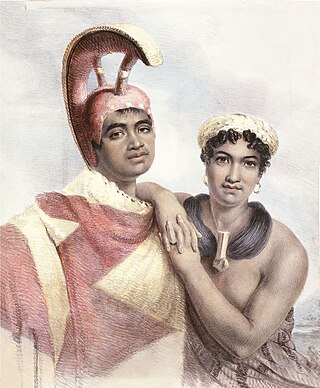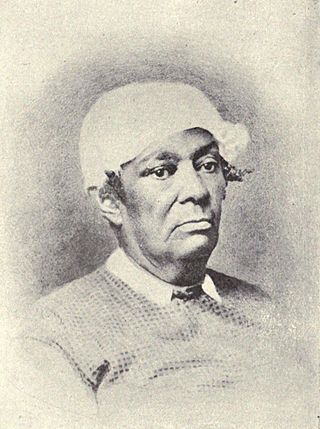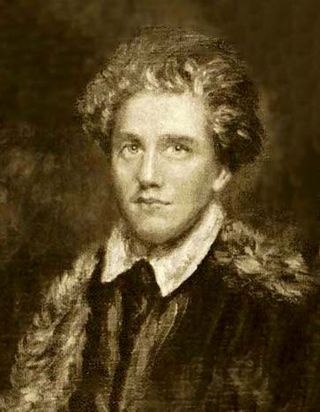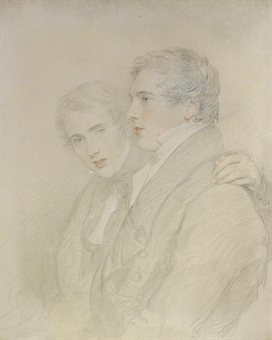Early life
| | This section is empty. You can help by adding to it. (January 2022) |
James Macrae was a Scottish botanist.
| | This section is empty. You can help by adding to it. (January 2022) |
| | This section is empty. You can help by adding to it. (April 2022) |
In 1824, James Macrae was sent by the Royal Horticultural Society, [1] aboard the H.M.S Blonde [2] to gather botanical and agricultural information, collect plants and give seeds to Hawaiians. Another naturalist Andrew Bloxam whose brother Rowland was ship's chaplain. [3] Ship's artist Robert Dampier also made several important paintings on the voyage. [4] Maria Graham (later, Maria Callcott) wrote a book about the voyage of the H.M.S. Blonde including an account of the voyage and funeral ceremony for the Hawaiian sovereigns whose bodies were being returned to the Kingdom of Hawai'i. [5]
After the specimen hunting voyage to the Kingdom of Hawai'i, Macrae was sent to Ceylon to work at the Royal Botanical Gardens, Peradeniya.
James Macrae died in Ceylon (Sri Lanka) in 1830.
The standard author abbreviation J.Macrae is used to indicate this person as the author when citing a botanical name . [6]
Charles Robert Malden, was a nineteenth-century British naval officer, surveyor and educator. He is the discoverer of Malden Island in the central Pacific, which is named in his honour. He also founded Windlesham House School at Brighton, England.

Kamehameha II was the second king of the Kingdom of Hawaii. His birth name was Liholiho and full name was Kalaninui kua Liholiho i ke kapu ʻIolani. It was lengthened to Kalani Kaleiʻaimoku o Kaiwikapu o Laʻamea i Kauikawekiu Ahilapalapa Kealiʻi Kauinamoku o Kahekili Kalaninui i Mamao ʻIolani i Ka Liholiho when he took the throne.

Kuini Liliha was a High Chiefess (aliʻi) and noblewoman who served the Kingdom of Hawaii as royal governor of Oʻahu island. She administered the island from 1829 to 1831 following the death of her husband Boki.

Starbuck Island is an uninhabited coral island in the central Pacific, and is part of the Central Line Islands of Kiribati. Former names include "Barren Island", "Coral Queen Island", "Hero Island", "Low Island", and "Starve Island".

Maria Graham, later Maria, Lady Callcott, was a British writer of travel books and children's books, and also an accomplished illustrator. Her observations of how earthquakes can change the land surface proved controversial, but correct.
The Mauke starling or mysterious starling was a species of starling found on the island of Mauke, Cook Islands. It is now extinct. The binomen is the result of Buller's misreading of the name inornata on the specimen label. As he seems to have genuinely believed this spelling to be correct, the binomial, although it has no meaning, is valid.

Betsey Stockton, sometimes spelled Betsy Stockton, was an American educator and missionary in Hawaii.

Captain Alexander Adams (1780–1871) was a Scotsman who served in the British Royal Navy and then came to the Hawaiian islands and served in the navy of the Kingdom of Hawaii. Known to the Hawaiians as Alika Napunako Adams.

The pueo is a subspecies of the short-eared owl and is endemic to Hawaii. The pueo is one of the more famous of the various physical forms assumed by ʻaumākua in Hawaiian culture.
Admiral George Anson Byron, 7th Baron Byron was a British nobleman, naval officer, peer, politician, and the seventh Baron Byron, in 1824 succeeding his cousin the poet George Gordon Byron, 6th Baron Byron in that peerage. As a career naval officer, he was notable for being his predecessor's opposite in temperament and lifestyle.

The O‘ahu ‘ō‘ō was a member of the extinct genus of the ‘ō‘ōs (Moho) within the extinct family Mohoidae. It was previously regarded as member of the Australo-Pacific honeyeaters (Meliphagidae).

Robert Dampier (1799–1874) was a British artist and clergyman.

Don Francisco de Paula Marín (1774–1837) was a Spaniard who became influential in the early Kingdom of Hawaii. Often called Manini, Marini or other variations, he became a confidant of Hawaiian King Kamehameha I. Marín acted as a jack-of-all-trades, sometimes even acting as a physician, probably without any formal education, and is credited with introducing many agricultural products.

Naihe-Kukui Kapihe, known as "Captain Jack" or "Jack the Pilot" to visitors, served as Honolulu harbor master and admiral of the royal fleet in the early Kingdom of Hawaii. His daughter would become a Queen consort.

The Waiākea Mission Station was the first Christian mission on the eastern side of the Island of Hawaiʻi. Also known as the Hilo Station, the latest structure is now called Haili Church.

High Chiefess Kapiʻolani was an important member of the Hawaiian nobility at the time of the founding of the Kingdom of Hawaiʻi and the arrival of Christian missionaries. One of the first Hawaiians to read and write, as well as sponsoring a church. She made a dramatic display of her new faith, which was the subject of a poem by Alfred, Lord Tennyson.

Naihe was the chief orator and councilor during the founding of the Kingdom of Hawaii. A champion athlete in his youth, he negotiated for peace at several critical times and helped preserve the remains of several ancient leaders.

HMS Blonde was a 46-gun modified Apollo-class fifth-rate frigate of 1,103 tons burthen. She undertook an important voyage to the Pacific Ocean in 1824. She was used for harbour service from 1850 and was renamed HMS Calypso in 1870, before being sold in 1895.

Andrew Bloxam was an English clergyman and naturalist; in his later life he had a particular interest in botany. He was the naturalist on board HMS Blonde during its voyage around South America and the Pacific in 1824–26, where he collected mainly birds. Later as a Church of England minister he lived in Warwickshire and Leicestershire and made significant contributions to the study of the natural history of the area. His special interest was in fungi and the genera Rubus and Rosa. His botanical author abbreviation is "A.Bloxam".

The era of European and American voyages of scientific exploration followed the Age of Discovery and were inspired by a new confidence in science and reason that arose in the Age of Enlightenment. Maritime expeditions in the Age of Discovery were a means of expanding colonial empires, establishing new trade routes and extending diplomatic and trade relations to new territories, but with the Enlightenment scientific curiosity became a new motive for exploration to add to the commercial and political ambitions of the past. See also List of Arctic expeditions and List of Antarctic expeditions.